- mamajanemassage
- May, 29, 2018
- Arvigo Techniques of Mayan Abdominal Massage, Birth Doula, Birth Massage, Mama Jane Massage, Postpartum Massage, Pregnancy, Prenatal Massage, Reflexology
- Comments Off on 10 Things I’ve Learned in My 10 Years as a Massage Therapist
10 Things I’ve Learned in My 10 Years as a Massage Therapist
by Liz Martin
It’s hard for me to believe, but it’s been ten years since I finished school and became a Licensed Massage Therapist! I’ve done thousands of massages, in many different kinds of venues. My education at Colorado School of Healing Arts was top notch, but nothing can compare to real life experience. When I started my list of “things I’ve learned” I had more than 20, but I pared them down to my top 10 list.
1. Self-care is essential
Adulting is hard and sometimes it feels like taking care of ourselves is a full-time job. You always hear people say, to take care of others you have to take care of yourself first. But when you’re a responsible adult who has kids or other dependents, sometimes you have to take care of others first. Taking care of a home – cleaning, repairs or renovations, yard work – can also be it’s own full-time job. And when you have bills to pay or a high-pressure job, sometimes your work has to come first. Our day-to-day lives easily become stressful, and stress does horrible things to our body and contributes to many health concerns such as fatigue, chronic pain, high blood pressure, heart disease, anxiety and depression, to name a few.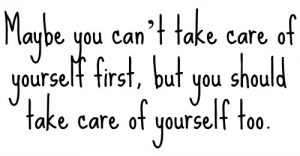
Maybe you can’t take care of yourself first, but you should take care of yourself too. Massage is an easy, effective way to do self-care, and it is very effective in counteracting the effects of stress on your body.
2. My client guides the session
Each massage session is unique, because each client is unique. My clients guide our sessions, not only with their preferences or requests, but with what their muscles and tissues tell me on an intuitive level. When I work on someone, I am feeling for tightness in the muscles or joints, looking at how they hold their body, feeling how they are responding to the pressure I’m using, and how what I’m feeling changes as I work. I might feel softening, heat, twitching, vibration; the client might tense or relax, change their breathing pattern, sink into my touch or slightly move away; their faces might smile or relax or grimace. All of these things inform what I do in the moment, and what I do next, and my ability to tap into these cues has only improved over time.
3. I wish everyone got a weekly massage
People often ask me how often they should get a massage, and my simplest answer is every week! In a perfect world, we all would have the time, money (or insurance coverage!), and place to get a massage every week. Just picture how relaxed, happy, pain-free and energetic we would all be if that were possible.
I challenge each of you to commit to one massage a week for a month and see how amazing you feel! (It doesn’t even have to be with me, ha! I just want you to take care of yourselves, and be happy & healthy!)
4. All bellies are beautiful – but are often ignored
In massage school, I learned some general relaxation and digestion techniques for the abdomen, and later on some postpartum-specific techniques. But it was the Arvigo Techniques of Mayan Abdominal Therapy® that really filled a gap in my knowledge about specific work on organs, lymphatic drainage and myofascial release in the abdomen. We can hold tension, pain and inflammation in our bellies, and it tends to be an area focused on the least during a full body massage.
I don’t automatically include abdominal massage in a session, unless I’m doing an Arvigo treatment or its clearly indicated that I should work on someone’s abdomen (for example if they have digestive concerns), and I always ask permission before including it. This is because our bellies tend to be a vulnerable area and many people feel self-conscious of their bellies or feel exposed when their bellies are touched.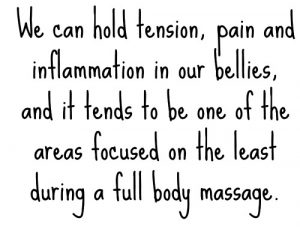
It is a privilege to be asked to give an abdominal massage to a client – you are invited into a part of their lives that is sacred, private, and often times painful. Having your belly massaged in a professional, nonjudgmental and caring way, can be truly healing. While I understand when people don’t want me to work on their bellies, I have learned that it is a missing piece in full body healing.
Massaging the belly improves digestion, reduces inflammation in the digestive system and other organs, stimulates lymphatic drainage, softens and releases the diaphragm, and encourages the uterus (if you have one) to be in its neutral position. When the uterus is in its neutral position, it releases hormones more optimally, your menstrual cycle is regulated, you feel fewer PMS symptoms, it can decrease back pain, and much more. Knowing all this, you can start to understand why working on the belly can be beneficial.
5. I don’t create pain, I find pain
If you’ve had a massage with me, you know that my pressure is naturally on the deeper end. I’ve always had strong hands, and I’ve become pretty good at using my body weight to my advantage. When I say “I don’t create pain, I find pain,” I don’t mean that I don’t sometimes use a little more pressure than is someone’s preference (I can usually tell and/or they will tell me, and I will lighten my pressure accordingly.) 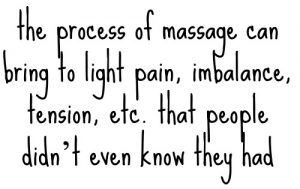
What I mean is the process of massage can bring to light pain, imbalance, tension, etc. that people didn’t even know they had. So many of us (myself included) have a disconnect between our mind and body, which makes it possible to have pain and tension in one’s body but have no idea. Massage helps to reconnect the mind with the body, bringing awareness to areas of ourselves that we ignore – which is an important first step in wellness.
6. Massage helps me connect to my doula clients on a deeper level
As a doula, I support families during the birth of their babies and I have made massage an important part of how I care for my doula clients. Prenatal massage helps them through pregnancy and prepare for birth, and postpartum massage helps them heal from birth. But more than that, massage helps me get to know and connect with my clients in a way I wouldn’t be able to otherwise.
Pregnancy and birth are very physical. Massaging my clients helps me understand how pregnancy is impacting their bodies, and how it may affect their birth. It helps me understand my clients’ energy, how they like to be touched, where they hold pain and tension, and how they deal with discomfort in their body. I take this knowledge into their birth space, and it helps me provide them with the best care possible during their birth. Additionally, my clients get used to my energy and my touch, and it can make it easier for them to imagine my presence at their birth.
7. Postpartum massage is just as important as prenatal massage
One of my main specialties is prenatal and postpartum massage. Many people would agree there are lots of great reasons to get a massage while pregnant – it helps to ease aches and pains, it helps maintain alignment in your back and pelvis, which helps to encourage optimal fetal positioning, it decreases stress and releases endorphins, improves sleep, decreases fluid retention, eases leg cramps and so much more! And while many people know about prenatal massage, postpartum massage is less known and less understood to be an integral part of postpartum healing. 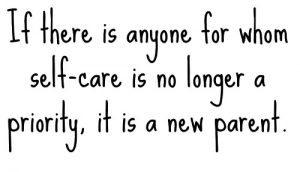
Depending on how soon after birth someone gets a massage, there are many important healing benefits. Postpartum massage can ease soreness or acute muscle injuries from the birth, address neck and shoulder tightness from nursing or bottle feeding, bring balance to your body when you’ve been carrying a baby on one hip, and sometimes most importantly, give the client an opportunity to have rest and relaxation without the baby. If there is anyone for whom self-care is no longer a priority, it is a new parent. It’s important that we remind new parents that they need to be cared for, too! And a massage is a great way to do that.
8. Yoga helps me understand anatomy in a more profound way
My anatomy education at the Colorado School of Healing Arts was incredible. That being said, I gained a much deeper understanding of anatomy when I started practicing yoga in 2010. Besides increasing my flexibility, strength and endurance, it gave me a whole new understanding about my body. It helped me realize the way I was using my body was creating chronic pain. Yoga made me feel what parts of my body were strong or weak, flexible or stiff. I already knew what each muscle did and where it attached to the bones, but yoga helped me actually feel it in my muscles. I gained a better understanding of what stretches and strengthening to do to address pain in the body, and this easily translated into how I massaged clients based on what they told me and what I felt in their body.
Yoga has also made me a better massage therapist – I started using better body mechanics as my core became stronger. And the stronger my body, the more longevity I will have in my massage career. Massaging people hurts! Getting my own massages and doing yoga helps me to take care of myself so I can take care of my clients.
9. Your Whole Body is Reflected in your Feet
While becoming a Certified Reflexologist in 2014, I learned so much about feet, and since then often use my clients’ feet to assess what else is going on in their bodies. Reflexology teaches that our organs and other body parts are reflected in the feet; if you work on certain parts of the feet, it will have an effect on the corresponding body part. I see it happening when I work on the digestive points in the feet, and then my client’s belly starts to make noise. Or I find tender spots in a client’s ankles, and it corresponds with reproductive concerns that they have.
Reflexology has influenced how I notice posture and gait. For example, if you step more on the ball of your foot, your toes will be tighter, but also your ankles and calves, and sometimes all the way up to the pelvis. Reflexology has basically just emphasized for me that our feet should not be ignored, and focusing on feet during a treatment can have a positive effect on what else is happening in someone’s body.
10. Move Your Body!
I once had someone ask me what is the best thing you can do for your body. I assumed they thought I would say massage, but I actually consider it to be the third most important thing.
I believe the #1 most important thing you can do for your body is move it! Being sedentary and immobile can cause long-term chronic pain and health problems. From simple things like walking, stretching, doing yoga, riding a bike, to more high impact activities like jogging/running, playing sports, cross-training, weight lifting, etc., the important thing is to move. 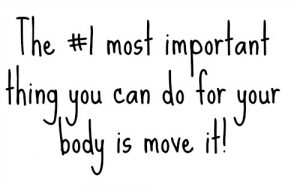
The second most important thing you can do for your body is put healthy things in it – hydrate, eat healthy, anti-inflammatory foods, reduce sugar & alcohol intake and don’t smoke. Put good things in your body and your body will feel good!
The third most important thing is bodywork! Be that massage, chiropractic, physical therapy, etc. – whatever works for you. A regular bodywork routine can help to support all the other great things you’re doing for yourself to be healthy.







